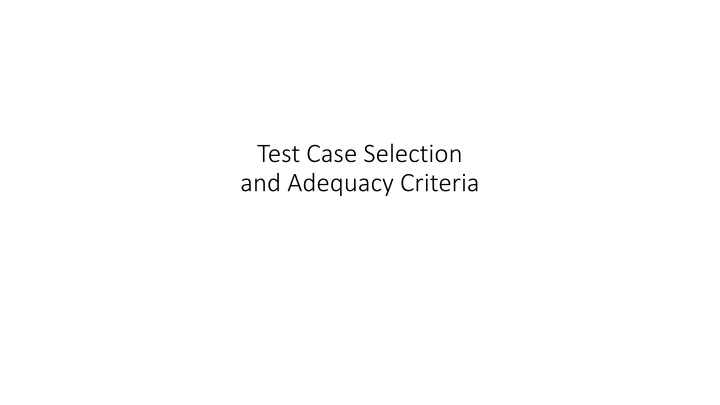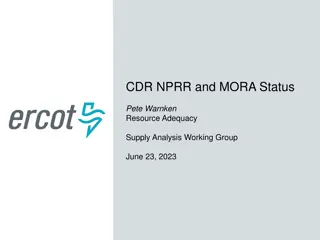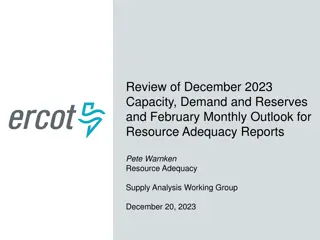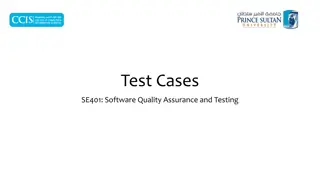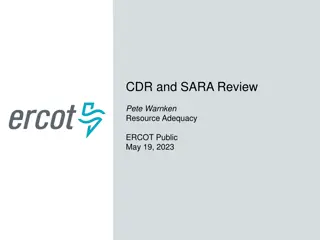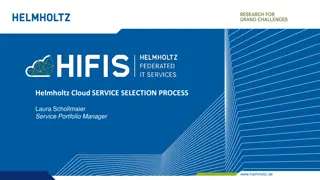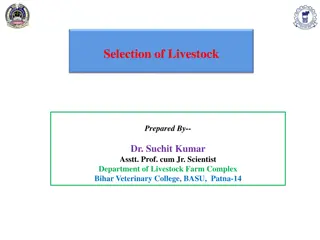Test Case Selection and Adequacy Criteria Explained
This article discusses the importance of defining test adequacy criteria, limitations, sources of information, and how test selection criteria are used. It emphasizes the challenges in achieving a truly effective testing system and highlights practical criteria to identify inadequacies in test suites. Drawing analogies with building codes, it explains how design rules and criteria play a crucial role in ensuring thoroughness in test design.
Download Presentation

Please find below an Image/Link to download the presentation.
The content on the website is provided AS IS for your information and personal use only. It may not be sold, licensed, or shared on other websites without obtaining consent from the author.If you encounter any issues during the download, it is possible that the publisher has removed the file from their server.
You are allowed to download the files provided on this website for personal or commercial use, subject to the condition that they are used lawfully. All files are the property of their respective owners.
The content on the website is provided AS IS for your information and personal use only. It may not be sold, licensed, or shared on other websites without obtaining consent from the author.
E N D
Presentation Transcript
Test Case Selection and Adequacy Criteria
Learning objectives Understand the purpose of defining test adequacy criteria, and their limitations Understand basic terminology of test selection and adequacy Know some sources of information commonly used to define adequacy criteria Understand how test selection and adequacy criteria are used
Adequacy: We cant get what we want What we would like: A real way of measuring effective testing If the system system passes an adequate suite of test cases, then it must be correct (or dependable) But that s impossible! Adequacy of test suites, in the sense above, is provably undecidable. So we ll have to settle on weaker proxies for adequacy Design rules to highlight inadequacy of test suites
Adequacy Criteria as Design Rules Many design disciplines employ design rules E.g.: traces (on a chip, on a circuit board) must be at least ___ wide and separated by at least ___ The roof must have a pitch of at least ____ to shed snow Interstate highways must not have a grade greater than 6% without special review and approval Design rules do not guarantee good designs Good design depends on talented, creative, disciplined designers; design rules help them avoid or spot flaws Test design is no different
Practical (in)Adequacy Criteria Criteria that identify inadequacies in test suites. Examples if the specification describes different treatment in two cases, but the test suite does not check that the two cases are in fact treated differently, we may conclude that the test suite is inadequate to guard against faults in the program logic. If no test in the test suite executes a particular program statement, the test suite is inadequate to guard against faults in that statement. If a test suite fails to satisfy some criterion, the obligation that has not been satisfied may provide some useful information about improving the test suite. If a test suite satisfies all the obligations by all the criteria, we do not know definitively that it is an effective test suite, but we have some evidence of its thoroughness.
Analogy: Building Codes Building codes are sets of design rules Maximum span between beams in ceiling, floor, and walls; acceptable materials; wiring insulation; ... Minimum standards, subject to judgment of building inspector who interprets the code You wouldn t buy a house just because it s up to code It could be ugly, badly designed, inadequate for your needs But you might avoid a house because it isn t Building codes are inadequacy criteria, like practical test adequacy criteria
Some useful terminology Test case: a set of inputs, execution conditions, and a pass/fail criterion. Test obligation: a partial test case specification, requiring some property deemed important to thorough testing. Test suite: a set of test cases. Test or test execution: the activity of executing test cases and evaluating their results. Adequacy criterion: a predicate that is true (satisfied) or false (not satisfied) of a program, test suite pair.
Where do test obligations come from? Functional (black box, specification-based): from software specifications Example: If spec requires robust recovery from power failure, test obligations should include simulated power failure Structural (white or glass box): from code Example: Traverse each program loop one or more times. Model-based: from model of system Models used in specification or design, or derived from code Example: Exercise all transitions in communication protocol model Fault-based: from hypothesized faults (common bugs) Example: Check for buffer overflow handling (common vulnerability) by testing on very large inputs
Adequacy criteria Adequacy criterion = set of test obligations A test suite satisfies an adequacy criterion if all the tests succeed (pass) every test obligation in the criterion is satisfied by at least one of the test cases in the test suite. Example: the statement coverage adequacy criterion is satisfied by test suite S for program P if each executable statement in P is executed by at least one test case in S, and the outcome of each test execution was pass .
Satisfiability Sometimes no test suite can satisfy a criterion for a given program Example: Defensive programming style includes can t happen sanity checks if (z < 0) { throw new LogicError( z must be positive here! ) } No test suite can satisfy statement coverage for this program (if it s correct)
Coping with Unsatisfiability Approach A: exclude any unsatisfiable obligation from the criterion. Example: modify statement coverage to require execution only of statements that can be executed. But we can t know for sure which are executable! Approach B: measure the extent to which a test suite approaches an adequacy criterion. Example: if a test suite satisfies 85 of 100 obligations, we have reached 85% coverage. Terms: An adequacy criterion is satisfied or not, a coverage measure is the fraction of satisfied obligations
Coverage: Useful or Harmful? Measuring coverage (% of satisfied test obligations) can be a useful indicator ... Of progress toward a thorough test suite, of trouble spots requiring more attention ... or a dangerous seduction Coverage is only a proxy for thoroughness or adequacy It s easy to improve coverage without improving a test suite (much easier than designing good test cases) The only measure that really matters is (cost-)effectiveness
Comparing Criteria Can we distinguish stronger from weaker adequacy criteria? Empirical approach: Study the effectiveness of different approaches to testing in industrial practice What we really care about, but ... Depends on the setting; may not generalize from one organization or project to another Analytical approach: Describe conditions under which one adequacy criterion is provably stronger than another Stronger = gives stronger guarantees One piece of the overall effectiveness question
The subsumes relation Test adequacy criterion A subsumes test adequacy criterion B iff, for every program P, every test suite satisfying A with respect to P also satisfies B with respect to P. Example: Exercising all program branches (branch coverage) subsumes exercising all program statements A common analytical comparison of closely related criteria Useful for working from easier to harder levels of coverage, but not a direct indication of quality
Uses of Adequacy Criteria Test selection approaches Guidance in devising a thorough test suite Example: A specification-based criterion may suggest test cases covering representative combinations of values Revealing missing tests Post hoc analysis: What might I have missed with this test suite? Often in combination Example: Design test suite from specifications, then use structural criterion (e.g., coverage of all branches) to highlight missed logic
Summary Adequacy criteria provide a way to define a notion of thoroughness in a test suite But they don t offer guarantees; more like design rules to highlight inadequacy Defined in terms of covering some information Derived from many sources: Specs, code, models, ... May be used for selection as well as measurement With caution! An aid to thoughtful test design, not a substitute
